Measure Influencer Marketing ROI: 5 Fast Formulas for 2025
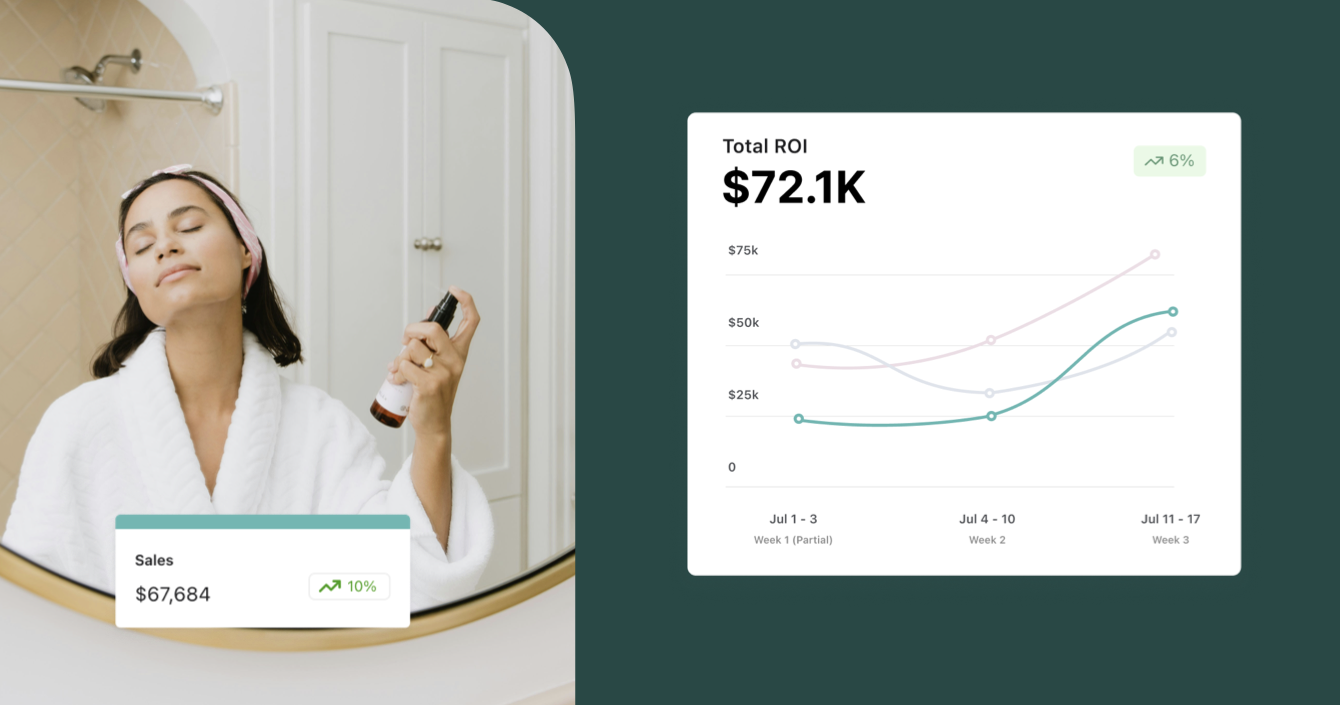
You don't need a complex equation to measure influencer marketing ROI. With brands spending an estimated $9.29 billion on influencer-related marketing campaigns in 2025 (a 14.2% increase from 2024), proving your campaigns' financial value has never been more critical.
Here's what we've learned from working with top brands: 70% of brands are measuring the ROI of their influencer marketing campaigns, and the most successful ones use these 5 proven formulas. Whether you're tracking direct sales or building brand awareness, we'll show you exactly how to measure what matters most to your business.
Why Measuring Influencer Marketing ROI Is Your Competitive Advantage
According to Influencer Marketing Hub, influencers collectively created 1.4 billion posts, generating $236 billion in Earned Media Value (EMV) in 2024. This represents a remarkable 8.4x return on investment, making influencer marketing one of your most effective growth channels.
Yet most brands struggle with measurement. In fact, more marketers say measuring creator performance is their biggest roadblock to a successful influencer program than any other factor. Bit without proper measurement, you're missing opportunities to optimize and scale.
Here's why tracking your influencer marketing ROI gives you an edge:
- Secure bigger budgets: Prove campaign value to stakeholders
- Identify winning strategies: Find your top-performing influencers and content
- Optimize resource allocation: Make data-driven decisions for future campaigns
- Outperform competitors: Brands focusing on performance metrics like EMV improve their ROI
Industry secret: The most successful brands use platforms like Aspire to automatically track comprehensive analytics across all influencer partnerships. With Aspire's advanced measurement capabilities, you can track everything from sales through affiliates to increases in brand lift with sponsored content — all in one dashboard.
Formula 1: Basic Revenue ROI (Your Starting Point)
This is your foundational formula for measuring direct revenue impact. Most successful brands start here because it provides immediate, tangible results you can present to stakeholders.
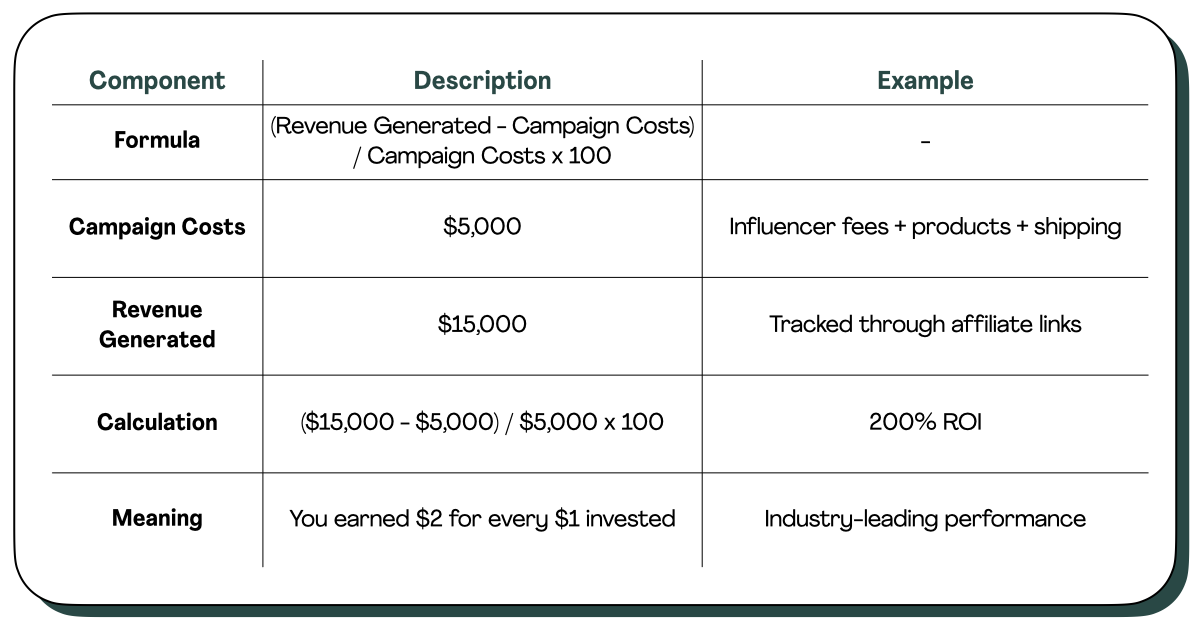
What Smart Brands Include in Campaign Costs
- Influencer compensation: Fees, commissions, product gifting
- Fulfillment costs: Product samples, shipping, packaging
- Content production: Photography, videography, editing
- Platform and tool costs: Software subscriptions, affiliate tracking
- Internal resources: Team time, management overhead
When to Use Basic Revenue ROI
Primary use cases:
- E-commerce brands with clear sales attribution
- Product launches using discount codes or affiliate links
- Direct-to-consumer campaigns with immediate conversion goals
- Performance marketing initiatives focused on sales
Pro tip: Aspire's tracking system makes this measurement automatic, eliminating manual calculation errors.
Formula 2: Earned Media Value (EMV) ROI (The Brand Awareness Champion)
EMV quantifies the monetary worth of organic exposure your brand receives. EMV is a metric many brands look at to measure ROI because it translates social metrics into dollar value.
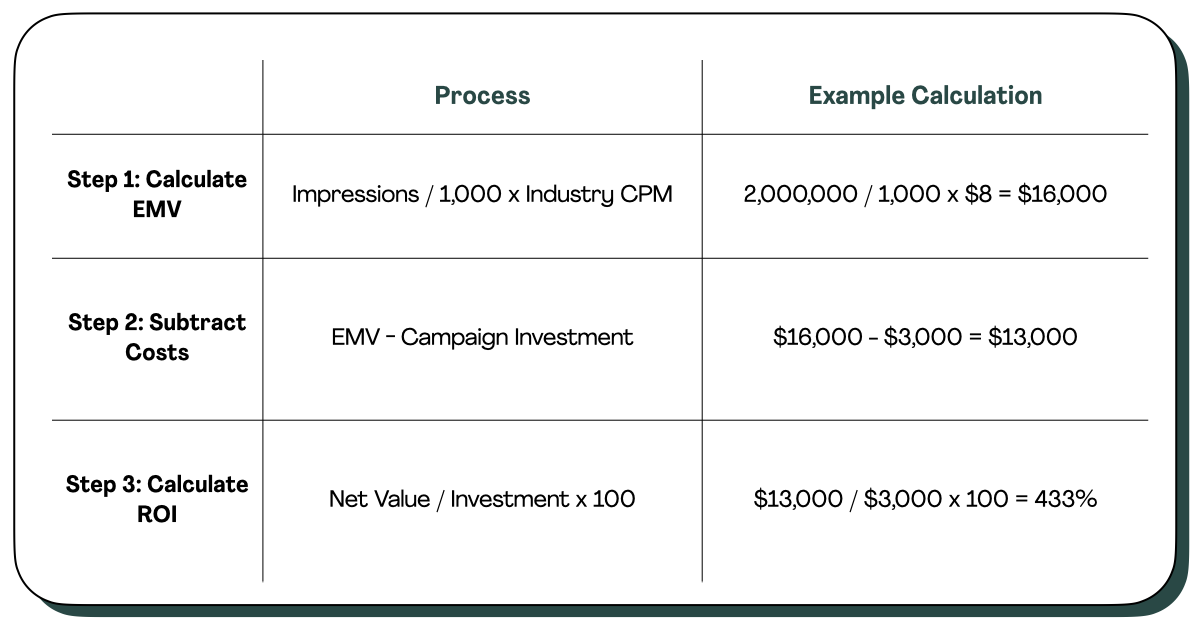
Advanced EMV Insights Most Marketers Miss
Industry CPM benchmarks by platform (2025):
- Instagram Feed: $6-12
- Instagram Stories: $4-8
- TikTok: $10-15
- YouTube: $8-20
Expert insight: The most accurate EMV calculations multiply impressions by platform-specific CPMs. For example, if your brand content receives 50,000 TikTok impressions with a $12 CPM, your EMV equals $600.
When EMV ROI Delivers Maximum Value
- Brand awareness campaigns without direct attribution
- Multi-platform strategies requiring unified measurement
- Executive reporting that needs advertising-equivalent metrics
- Competitive benchmarking against industry standards
Aspire advantage: Our platform automatically calculates EMV using real-time platform data, giving you the most accurate measurements in the industry.
Formula 3: Cost Per Engagement (CPE) ROI (The Quality Indicator)
This formula reveals engagement efficiency, which is crucial for building authentic communities. Smart brands use CPE to identify influencers who drive genuine interaction, not just vanity metrics.
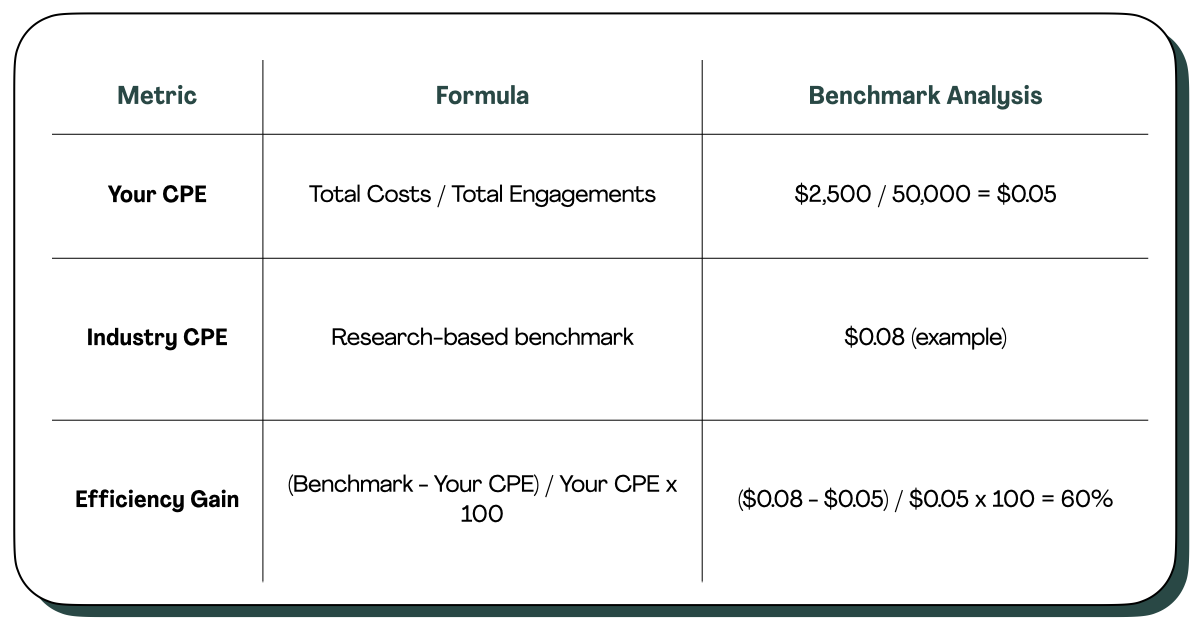
High-Value Engagement Metrics You Should Track
Primary engagement indicators:
- Comments with 3+ words indicates genuine interest
- Saves and shares shows content value and intent to revisit
- Story interactions like polls, questions, swipe-ups demonstrate active participation
- Profile visits and follows showcase direct interest in updates from your brand
Advanced insight: Micro-influencers achieve 60% higher engagement rates than macro-influencers due to stronger audience relationships. Use CPE to identify these high-efficiency partnerships.
Strategic Applications for CPE ROI
- Influencer tier comparison: Compare micro vs. macro effectiveness
- Content type optimization: Identify your highest-engaging formats
- Community building: Focus on relationships over reach
- Budget reallocation: Shift spend toward high-engagement partners
Formula 4: Customer Lifetime Value (LTV) ROI (The Long-Term View)
This advanced approach considers the total value of customers acquired through influencer marketing. We recommend this for brands with subscription models or high repeat purchase rates.
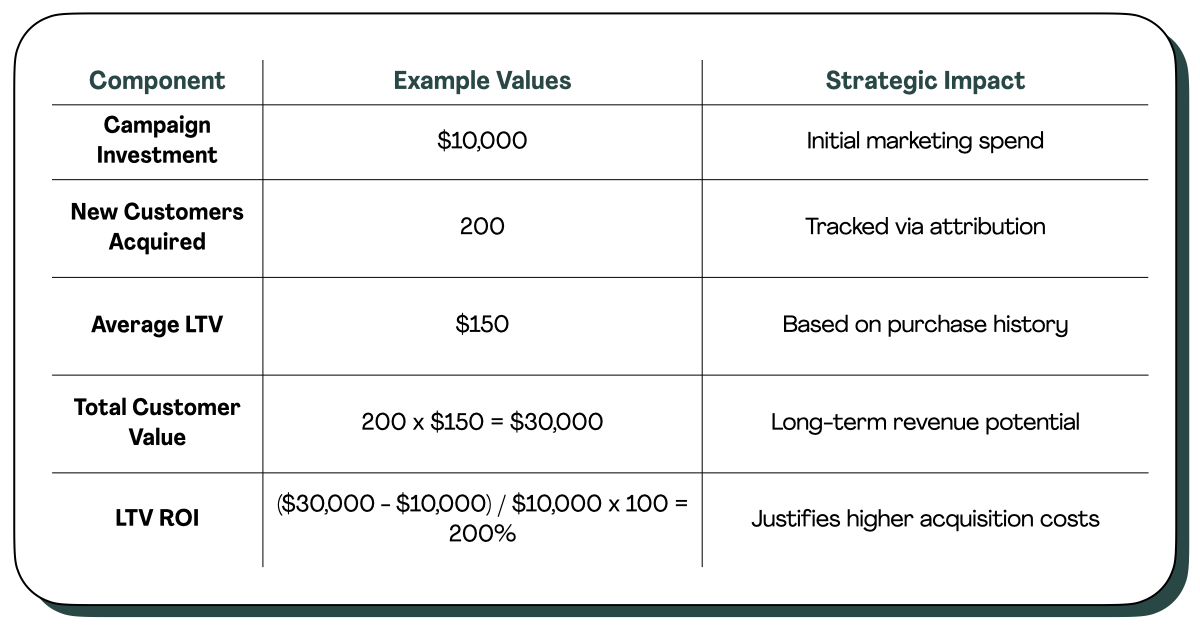
How We Calculate Accurate Customer Lifetime Value
LTV = (Average Order Value × Purchase Frequency × Customer Lifespan) - Customer Acquisition Cost
Critical tracking requirements:
- Extended attribution windows: 90-180 days minimum
- Cohort analysis: Track customer behavior over time
- Repeat purchase rates: Measure retention by acquisition channel
- Churn analysis: Understand when and why customers leave
When CLV ROI Transforms Your Strategy
- Subscription businesses: SaaS, memberships, recurring services
- High-value products: Luxury goods, B2B solutions, major purchases
- Loyalty programs: Building long-term customer relationships
- Strategic planning: Justifying higher upfront acquisition costs
Aspire integrates with your ecommerce platform to make this advanced measurement more accessible.
Formula 5: Multi-Touch Attribution ROI (The Complete Picture)
Your most sophisticated approach acknowledges that customers interact with multiple touchpoints before converting. This gives you the most accurate view of influencer marketing's true contribution.
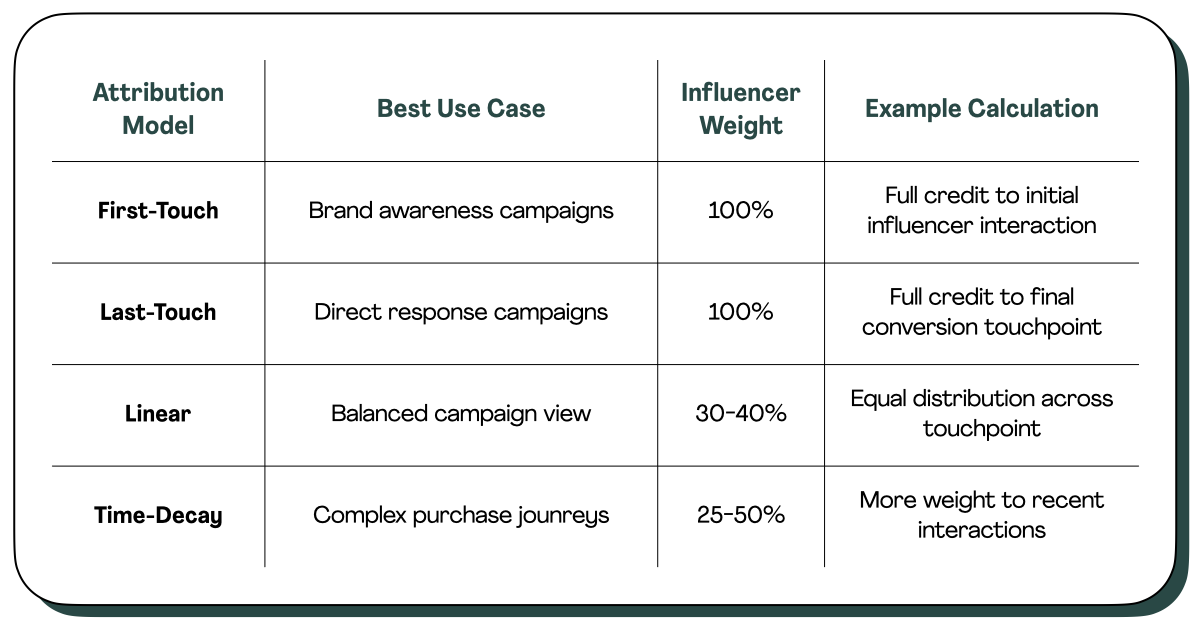
Advanced Multi-Touch Implementation
Essential tracking infrastructure:
- UTM parameter standards: Consistent campaign labeling
- Cross-platform pixel integration: Facebook, Google, TikTok tracking
- Customer journey mapping: Visualization of touchpoint sequences
- Attribution modeling software: Advanced analytics platforms
Multi-Touch ROI Calculation Example
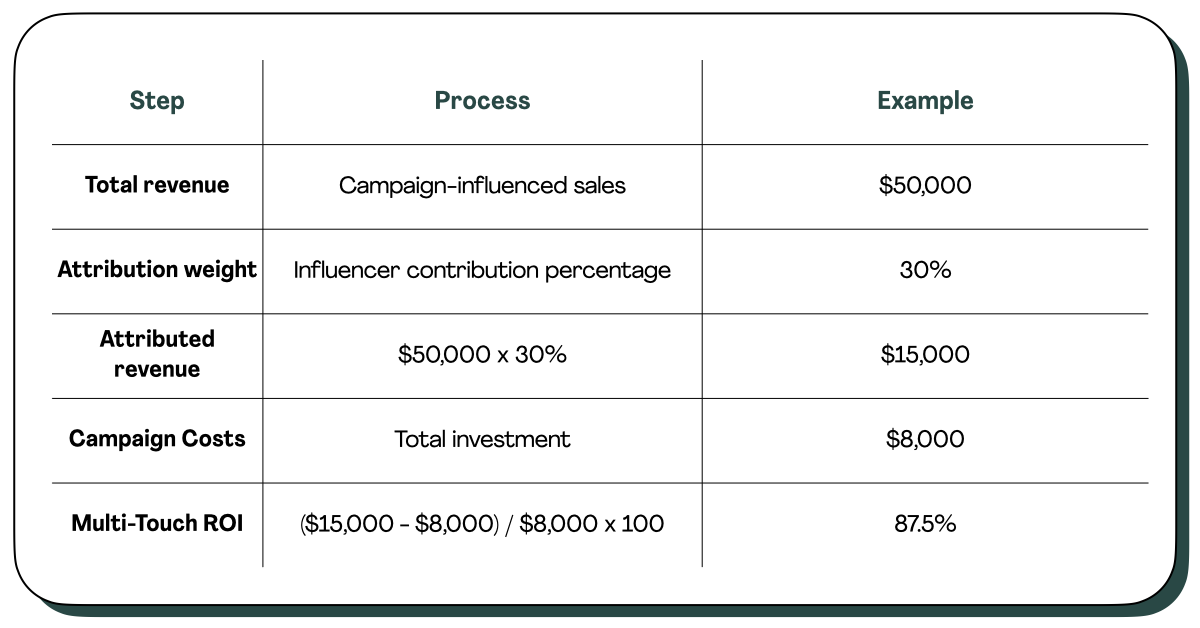
When Multi-Touch Attribution Is Essential
- Complex B2B sales: Long consideration periods
- High-value purchases: Cars, homes, luxury items
- Omnichannel strategies: Multiple marketing channels active
- Attribution disputes: Need to prove influencer marketing value
Advanced Metrics Beyond Basic ROI
Top-performing brands track these additional metrics to build comprehensive measurement frameworks:
Engagement Quality Indicators
- Engagement rate by follower size: 90% of influencer marketing programs track engagement as a metric
- Sentiment analysis: Positive vs. negative comment ratios
- Share-to-impression ratio: Content virality indicator
- Click-to-engagement ratio: Intent measurement
Brand Impact Metrics
- Brand mention lift — Organic conversation increases
- Share of voice growth — Your percentage of industry discussions
- Hashtag adoption rates — Campaign-specific tag usage
- User-generated content volume — Authentic customer creations
Conversion Funnel Analysis
- Influencer traffic behavior: Most marketers track clicks (59%), impressions (55%), and conversions (54%) in campaigns
- Page depth and session duration: Engagement quality on your site
- Email signup rates: Lead generation effectiveness
- Shopping cart completion: Purchase intent follow-through
Critical ROI Measurement Mistakes You Must Avoid
These common errors can completely invalidate your ROI calculations:
1. Hidden Cost Oversight
Many brands overlook additional costs like shipping charges for sending products to influencers, production costs, or influencer software platform fees. Include every expense — even small costs add up quickly.
2. Inadequate Attribution Windows
Most brands use too-short tracking periods. 49% of consumers' daily, weekly or monthly purchases are driven by influencer content, and 86% of consumers make a purchase inspired by an influencer at least once per year. Use 60-90 day windows minimum.
3. Ignoring Soft Value
Don't ignore hard-to-quantify benefits like increased user-generated content, brand awareness, customer loyalty, engagement, or sentiment. These contribute significantly to long-term success.
4. Inconsistent Methodology
Use identical calculation methods when comparing campaigns, time periods, or influencers. Mixed methodologies produce misleading results.
5. Short-Term Optimization
According to our survey, brand ambassador programs delivered the highest ROI for brands compared to other kinds of campaigns — proving that relationship building outperforms transactional approaches.
Technology Stack for Professional ROI Measurement
Successful brands use integrated technology to eliminate manual calculation errors and provide real-time insights:
All-in-One Platform (Recommended)
Aspire leads the industry with comprehensive influencer marketing measurement. Our platform provides:
- Real-time ROI tracking across all campaign types
- Automated EMV calculation using current platform data
- Affiliate tracking including number of sales, average order value, and more
- Actionable insights into both paid and organic content performance
- Advanced reporting with executive-ready visualizations
Supporting Analytics Tools
- Google Analytics 4: Enhanced ecommerce and conversion tracking
- Platform pixels: Facebook, TikTok, Pinterest native attribution
- Heat mapping software: User behavior analysis on landing pages
eCommerce Integrations
- Shopify Plus: Advanced analytics and custom attribution
- WooCommerce: WordPress-based tracking and reporting
- Custom APIs: Enterprise-level data integration
Your Next Steps to Measure Influencer Marketing ROI
Start implementing these formulas immediately using this prioritized approach:
Week 1: Foundation Building
- Implement basic revenue ROI for all current campaigns
- Set up proper cost tracking including all hidden expenses
- Establish attribution windows of 60-90 days minimum
- Integrate Aspire's measurement tools for automated tracking
Week 2: Advanced Metrics
- Calculate EMV for brand awareness campaigns
- Implement CPE tracking for engagement quality
- Set up multi-touch attribution for complex campaigns
Week 3: Strategic Optimization
- Analyze customer LTV for long-term planning
- Create executive dashboards with key metrics
- Identify top-performing influencers for relationship building
Remember: Businesses gain $6.50 in revenue for every $1 spent on influencer marketing when campaigns are properly measured and optimized. The key is consistent tracking and strategic decision-making based on data.
Ready to transform your influencer marketing measurement? Aspire's comprehensive platform automates these calculations and provides real-time insights across all your campaigns. You can focus on strategy while our technology handles the complex data analysis.
Book a demo of Aspire and see how industry-leading brands measure and optimize their influencer marketing ROI.


